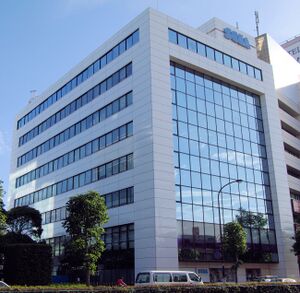Difference between revisions of "Sega AM2"
From Sega Retro
| Line 6: | Line 6: | ||
| headquarters=Japan | | headquarters=Japan | ||
| prev=[[Sega R&D 8]] | | prev=[[Sega R&D 8]] | ||
| − | | next=[[ | + | | next=[[AM2 of CRI]] |
}} | }} | ||
'''Sega Amusement Machine Research and Development Department #2''', ('''Sega AM R&D Dept. #2''', '''Sega AM2''' (セガエイエムツー), '''Sega AM2-ken''' (セガAM2研)) is a division within [[Sega Interactive (Japan)|Sega Interactive]] (formely [[Sega Enterprises]] and [[Sega Corporation]]). It was formed in 1990 primarily to create arcade (or "amusement") games. | '''Sega Amusement Machine Research and Development Department #2''', ('''Sega AM R&D Dept. #2''', '''Sega AM2''' (セガエイエムツー), '''Sega AM2-ken''' (セガAM2研)) is a division within [[Sega Interactive (Japan)|Sega Interactive]] (formely [[Sega Enterprises]] and [[Sega Corporation]]). It was formed in 1990 primarily to create arcade (or "amusement") games. | ||
Revision as of 11:16, 27 July 2022

| ||
| Sega AM2 | ||
|---|---|---|
| Founded: 1990 | ||
| Merged with: Sega AM3 (2008) | ||
| Merged into: Sega AM11, Digital Rex | ||
Headquarters:
| ||
Sega Amusement Machine Research and Development Department #2, (Sega AM R&D Dept. #2, Sega AM2 (セガエイエムツー), Sega AM2-ken (セガAM2研)) is a division within Sega Interactive (formely Sega Enterprises and Sega Corporation). It was formed in 1990 primarily to create arcade (or "amusement") games.
Contents
- 1 Current Members
- 2 Former Members
- 3 History
- 4 Softography
- 5 Gallery
- 6 External links
- 7 References
Current Members
- Daichi Katagiri
- Fumio Ito
- Hiroaki Shoji
- Hiroshi Kataoka
- Junpei Mishima
- Kazuki Takagi
- Keisuke Tsukahara
- Kenji Kanno
- Makito Nomiya
- Makoto Osaki
- Masayuki Masumi
- Megumi Takano
- Mie Kumagai
- Naoto Oike
- Noriyuki Shimoda
- Nobuyuki Yamashita
- Seiji Aoki
- Shinichi Goto
- Shinichi Yoshino
- Shoichiri Kanazawa
- Takehiko Mikami
- Takeshi Goden
- Tatsuya Sato
- Takuji Masuda
- Yasuyuki Nagata
Former Members
- Akira Yamanaka
- Daisuke Sato
- Hideaki Miyamoto
- Hidenori Shoji
- Junichi Yamada
- Keiji Okayasu
- Maki Morrow
- Masanori Takeuchi
- Mika Kojima
- Sachio Ogawa
- Satoshi Mifune
- Seiichi Hamada
- Seiichi Ishii
- Seiichiro Matsumura
- Takayuki Nakamura
- Takashi Fujimura
- Takenobu Mitsuyoshi
- Takeshi Isone
- Tatsutoshi Narita
- Tetsuya Kaku
- Tomoya Koga
- Tomoyuki Kawamura
- Tohru Nakabayashi
- Toru Ikebuchi
- Toshihiro Nagoshi
- Wataru Sakomura
- Yasuhiro Takagi
- Yasushi Nakajima
- Yu Suzuki
- Yukinobu Arikawa
- Fumio Kurokawa
History

Sega restructured its internal R&D divisions around 1990/1991, and Sega AM2, the second "amusement machine" division emerged from Sega R&D 8. Clearly dividing the arcade and consumer (CS) teams meant that AM2 would be focused entirely on arcade games (R&D 8 having also produced two Sega Mega Drive titles; Sword of Vermilion and Rent A Hero). The divide would not stick - by 1994 AM2 were involved with Mega Drive and Sega Saturn conversions of their popular titles, but the group was first and foremost an arcade division.
The change to AM2 coincided with a change in the industry. Atari Games and Namco were edging ahead of Sega by producing 3D video games comprised of polygons, so Sega, with heavy influence from AM2, began work on the Model 1 board - a "CG" arcade system capable of rendering thousands of polygons at high frame rates. It was during this period where AM2 abandoned the taikan game formula which had seen success for its predecessors during the 1980s, to focus on supporting this new, true 3D system.
1992's Virtua Racing, demonstrating the Model 1 board, was the first game to be produced by AM2[2]. Following this, two teams were formed, one that would work on Virtua Fighter, and another on Daytona USA[2], the latter for the improved Sega Model 2 hardware. These three games, the latter two proudly showing AM2's new "palm tree" logo, elevated the company to new heights and made their producer, Yu Suzuki a video game celebrity.
Success for AM2 continued with Virtua Cop, Virtua Fighter 2, Virtua Striker (led by Satoshi Mifune) and Fighting Vipers, with the Model 3 games Scud Race (led by Toshihiro Nagoshi) and Virtua Fighter 3 making Sega leaders in the arcade throughout the 1990s. AM2 also had an important role with the Sega Saturn, producing the Sega Graphics Library in 1995 in conjunction with its Saturn conversion of Virtua Fighter 2.
Among its home conversions, Fighters Megamix, perhaps a celebration of the company's efforts to that point, was released for the console, combining the rosters of Virtua Fighter and Fighting Vipers (alongside a plethora of others, including a playable AM2 palm tree). It was towards the end of the decade, however, when Yu Suzuki AM2 embarked on its most ambitious project to date - the Dreamcast epic, Shenmue.
As with other R&D divisions within Sega, Sega AM2 was briefly renamed Sega Software R&D Dept. #2 in May 1999. Unlike its sister divisions, however, the department continued to trade as AM2 and was largely unaffected by the internal restructure.
AM2 of CRI
CSK had been the parent company of Sega since 1984, running its own software development division, CSK Research Institute during the 1990s. Isao Okawa personally bought the division from CSK on 1st October, 1999[3], and in February 2000, it was merged with Sega AM2, creating the short-lived title, AM2 of CRI. CRI Middleware was then established to handle the sale of CRI's former products such as ADX and Sofdec.
AM2 of CRI existed for much of 2000 and part of 2001, continuing to operate as it had before, but downplaying the use of "Sega" and the iconic palmtree logo over this period.
As a stand-alone company
While a few games were released by AM2 of CRI, the CRI name would be dropped later in August 2001, when, as with other development groups within Sega, AM2 was spun-off into an entirely separate (but wholly owned) subsidiary of Sega known as Sega-AM2 Co., Ltd.[4][5]. This is the only official iteration of the company to have a hypen between "Sega" and "AM2".
CRI staff however stayed at Sega AM2, with Noriyuki Shimoda and Seiji Oaki eventually becoming prominent staff. However due to too much unfamiliar staff, Yu Suzuki found himself unwilling to continue manage AM2, and instead formed Digital Rex in 2003.
Sega's separate development companies were merged back into the main business in 2004, and this included AM2, trading once again as "AM R&D Dept. 2". The arcade industry became limited to Japan, and Sega's initiative for it's arcade studios to produce console titles filtered out. Therefore Sega AM2 became much more low key compared to the global impact it had in the past. Nonetheless Virtua Fighter 4, MJ and Border Break had new features that contribute to Sega's arcade business. This includes nationwide internet play in arcades, and also mobile applications connecting to the arcade games.
Ports of arcade titles developed by AM2 continue to be well received, such as Virtua Fighter 5 and Cyber Troopers Virtual-On Oratorio Tangram, however became less common in comparision to the past. It was once mentioned by AM2 staff there is a strange atmosphere that console staff could dissapear anytime.[6]
In April 2009, a restructure took place within Sega's arcade software studios, with part of Sega AM3 staff ended up at AM2. Around this time, AM2 also branched out to mobile development, mainly with AM3 staff, with titles like Virtua Tennis Challenge and Derby Owners Club.
Overall Sega AM1 is Sega's more prominent arcade division as of recent, with a higher amount of successfull titles.
Softography
System 32
- Arabian Fight (1991)
- Rad Rally (1991)
- Soreike Kokology (1992)
- F1 Super Lap (1993)
- Burning Rival (1993)
Model 1
- Virtua Racing (1992)
- Virtua Fighter (1993)
- Virtua Formula (1993)
Model 2
- Desert Tank (1994)
- Virtua Cop (1994)
- Daytona USA (1994)
- Virtua Fighter 2 (1994)
- Fighting Vipers (1995)
- Virtua Cop 2 (1995)
- Virtua Striker (1995)
- Sonic the Fighters (1996)
Sega Titan Video
- Virtua Fighter Remix (1995)
- Virtua Fighter Kids (1996)
Model 3
- Virtua Fighter 3tb (1997)
- Virtua Striker 2 (1997)
- Scud Race Plus (1997)
- Fighting Vipers 2 (1998)
- Virtua Striker 2 Version '98 (1998)
NAOMI Multiboard
- F355 Challenge 2: International Course Edition (2001) (as AM2 of CRI)
NAOMI 2 GD-ROM
- Beach Spikers: Virtua Beach Volleyball (2001) (as AM2 of CRI)
Mega Drive
- Virtua Racing (1994)
Saturn
- Virtua Fighter Mihonban Hibaihin (1994)
- Virtua Fighter (1994)
- Virtua Cop (1995)
- Virtua Fighter Remix (1995)
- Virtua Fighter CG Portrait Series Vol. 1 Sarah Bryant (1995)
- Virtua Fighter CG Portrait Series Vol. 2 Jacky Bryant (1995)
- Virtua Fighter CG Portrait Series Vol. 3 Akira Yuki (1995)
- Virtua Fighter CG Portrait Series Vol. 4 Pai Chan (1995)
- Virtua Fighter CG Portrait Series Vol. 5 Wolf Hawkfield (1995)
- Virtua Fighter CG Portrait Series Vol. 6 Lau Chan (1995)
- Java Tea Original Virtua Fighter Kids (1996)
- Sega Ages: Volume 1 (1996)
- Virtua Cop 2 (1996)
- Virtua Fighter CG Portrait Series The Final Dural (1996)
- Virtua Fighter Kids (1996)
- Virtua Fighter CG Portrait Series Vol. 7 Shun Di (1996)
- Virtua Fighter CG Portrait Series Vol. 8 Lion Rafale (1996)
- Virtua Fighter CG Portrait Series Vol. 10 Jeffry McWild (1996)
- Virtua Fighter CG Portrait Series Vol. 9 Kage Maru (1996)
- Fighters Megamix (1996)
- Digital Dance Mix Vol. 1 Namie Amuro (1997)
- Virtua Cop 1-2 Pack (1998)
Dreamcast
- Shenmue (1999) (as AM2 of CRI)
- F355 Challenge (2000) (as AM2 of CRI)
- Charge 'N Blast (2000) (as AM2 of CRI)
- AM2 of CRI 2001 New Lineup Movie Collection (2001) (as AM2 of CRI)
- US Shenmue (2001) (as AM2 of CRI)
- Outtrigger (2001) (as AM2 of CRI)
- Virtua Fighter 4 Passport (2001) (as AM2 of CRI)
- Virtua Fighter History/VF4 (2001) (as AM2 of CRI)
PlayStation 2
- Virtua Cop: Elite Edition (2002) (as Sega-AM2)
- Virtua Quest (2004) (as Sega-AM2)
GameCube
- Virtua Quest (2004) (as Sega-AM2)
Windows PC
(old)
System 32
- Soreike Kokology 2 (1993)
Sega Model 2
- Virtua Striker (1995)
Sega Model 3
- Virtua Fighter 3 (1996)
- Scud Race (1996)
- Daytona USA 2: Battle on the Edge (1998)
- Daytona USA 2: Power Edition (1998)
NAOMI
- MJ (2002)
Chihiro
- MJ2 (2003)
Sega System SP
- Rhythm Tengoku (2007)
RingEdge
- Hatsune Miku: Project DIVA Arcade (2010)
- Sega Card-Gen MLB 2013 (2013)
PlayStation 2
Xbox 360
PlayStation 3
- Miyazato San Kyoudai Naizou: Sega Golfclub (2006) (with GE2)
- Cyber Troopers Virtual-On (2013)
Nintendo 3DS
PlayStation Vita
- Virtua Tennis 4 (2011)
- Hatsune Miku: Project DIVA F (2013) (with Sega CS3)
PC
- MJ (2013)
- Fortisia SEGAxLINE (2016)
Gallery
External links
- Official website
- Official website (Archived on 10 April 2001)
- Official website (Archived on 30 June 2004)
- IGN info page for Sega-AM2
References
- ↑ Edge, "June 1994" (UK; 1994-04-28), page 45
- ↑ 2.0 2.1 Edge, "June 1994" (UK; 1994-04-28), page 47
- ↑ File:CSK AnnualReport 2000.pdf, page 32
- ↑ http://dengekionline.com/data/news/2001/8/1/70e819844b813fbf73f290e563297591.html
- ↑ Dorimaga, "2001-07 (2001-08-24)" (JP; 2001-08-10), page 11
- ↑ http://blog.sega.jp/amcvt/ (Wayback Machine: 2014-03-28 15:31)
| Timeline of Sega of Japan research and development divisions |
|---|
|
83
84
85
86
87
88
89
90
91
92
93
94
95
96
97
98
99
00
01
02
03
04
05
06
07
08
09
10
11
12
13
14
15
16
17
18
19
20
21
22
|




